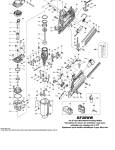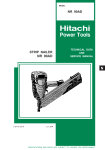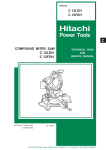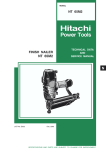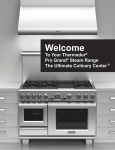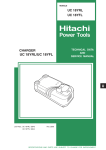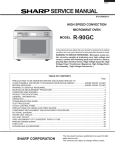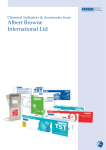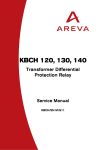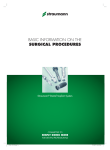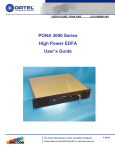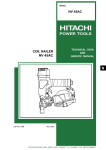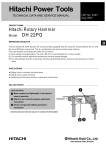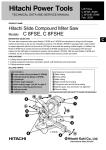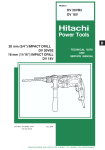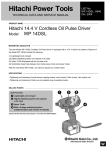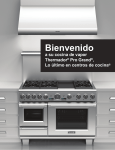Download Hitachi - NR90GC
Transcript
MODEL NR 90GC Hitachi Power Tools GAS STRIP NAILER NR 90GC TECHNICAL DATA AND SERVICE MANUAL N LIST No. E025 Sept. 2005 SPECIFICATIONS AND PARTS ARE SUBJECT TO CHANGE FOR IMPROVEMENT REMARK: Throughout this TECHNICAL DATA AND SERVICE MANUAL, a symbol is used in the place of company name and model name of our competitor. The symbol utilized here is as follows: Competitors Symbols Utilized P Company Name Model Name Paslode IMCT CONTENTS Page 1. PRODUCT NAME ........................................................................................................................... 1 2. MARKETING OBJECTIVE ............................................................................................................. 1 3. APPLICATIONS .............................................................................................................................. 1 4. SELLING POINTS .......................................................................................................................... 1 5. SPECIFICATIONS .......................................................................................................................... 2 5-1. Specifications .................................................................................................................................. 2 5-2. Explanation of the Nailing Action .................................................................................................... 2 5-3. Nail Selection .................................................................................................................................. 3 5-4. Nail Driving Force ........................................................................................................................... 4 6. COMPARISONS WITH SIMILAR PRODUCTS .............................................................................. 5 7. PRECAUTIONS IN SALES PROMOTION ..................................................................................... 6 7-1. Handling Instructions ...................................................................................................................... 6 7-2. Warning Label ................................................................................................................................. 6 7-3. Related Laws and Regulations ....................................................................................................... 8 8. MECHANISM AND OPERATION PRINCIPLE ............................................................................. 10 8-1. Mechanism ................................................................................................................................... 10 8-2. Principle of Operation ................................................................................................................... 12 9. TROUBLESHOOTING GUIDE ..................................................................................................... 16 9-1. Problems Caused by Improper Handling ...................................................................................... 16 9-2. Troubleshooting and Correction .................................................................................................... 19 9-3. Checking for Sparking and Corrective Action ............................................................................... 26 9-4. Regrinding the Driver Blade .......................................................................................................... 27 10. DISASSEMBLY AND REASSEMBLY ........................................................................................ 28 10-1. General Precautions in Disassembly and Reassembly .............................................................. 28 10-2. Disconnection and Reconnection of Wiring between Cylinder Head Section and Handle Section ............................................................................................................................ 31 10-3. Disassembly and Reassembly of Cylinder Head Section ........................................................... 34 10-4. Disassembly and Reassembly of Housing Section .................................................................... 39 10-5. Disassembly and Reassembly of Handle Section ...................................................................... 55 11. INSPECTION AND CONFIRMATION AFTER REASSEMBLY .................................................. 69 12. STANDARD REPAIR TIME (UNIT) SCHEDULES ..................................................................... 70 Assembly diagram for NR 90GC 1. PRODUCT NAME Hitachi 90 mm (3-1/2") Gas Strip Nailer, Model NR 90GC 2. MARKETING OBJECTIVE Today, one company has been monopolizing the gas nailer markets. We will enter the largest-scale clipped head (D-head) nailer market with the new Model NR 90GC gas strip nailer to expand our market share. The main features of the Model NR 90GC are as follows: (1) The battery is located at the end of the handle for well balance. (2) New aggressive appearance (3) 2-actioned nail feeding (4) Comfortable grip (5) Fully charged in one hour 3. APPLICATIONS Floor and framing Truss build-up, window build-up Subflooring and roof decking Wall sheathing Mobile home and modular housing construction 4. SELLING POINTS Well balance Comfortable grip New aggressive appearance Fully charged in one hour 2-actioned nail feeding --- 1 --- 5. SPECIFICATIONS 5-1. Specifications (1) Gas nailer NR 90GC Model Driving system Reciprocating piston type Weight 3.5 kg (7.7 lbs.) Dimensions (Length x Height x Width) 347 mm x 353 mm x 108 mm (13-21/32" x 13-29/32" x 4-1/4") Nail feed system Spiral spring Nail capacity 37 nails (1 strip) Packaging Plastic case Package dimensions (Length x Height x Width) 500 mm x 460 mm x 150 mm (19-11/16" x 18-5/32" x 5-29/32") Standard accessories - For North America Safety glasses (Code No. 875769) Optional accessories Battery (Code No. 324147) Charger UC 7SD Case (Code No. 885360) Allen wrench for M5 screw (Code No. 944458) - For Europe Safety glasses (Code No. 885549) Battery (Code No. 324148) Charger UC 7SD Case (Code No. 885360) Allen wrench for M5 screw (Code No. 944458) - For North America Lubricant oiler (A) (Code No. 885546) Fuel cell (Code No. 728980) Grease (Code No. 317918) - For Europe Lubricant oiler (A) (Code No. 885246) Fuel cell (Code No. 753600) Grease (Code No. 317918) 5-2. Explanation of the Nailing Action To meet the requirements of "ANSI SNT-101-2002" (USA), the Model NR 90GC is equipped with FULL SEQUENTIAL ACTUATION MECHANISM. FULL SEQUENTIAL ACTUATION MECHANISM First, press the pushing lever against the wood; next, pull the trigger to drive the nail. After nailing once, nailing will not be possible again until the trigger is released and pressed again. --- 2 --- 5-3. Nail Selection The Model NR 90GC utilizes D-head (clipped head) nails collated with paper tape. Applicable nail dimensions are shown below. Please note that screw-type nails cannot be used with the Model NR 90GC. Ensure that nails are as specified in Fig. 1. The Model NR 90GC utilizes D-head (clipped head) nails collated at an angle of 35 degrees which are the same as the nails utilized by P. However, some D-head nails made by other makers are collated at a different angle of 26 degrees. Use of such nails will cause clogging of nails and subsequent damage to the nailer. Also avoid use of misaligned nails or nails collated with a weak paper tape. Do not use P's 2" Roundrive nail (eccentric full round head nail) with the Model NR 90GC because it may cause bending of nails. It is recommended to use genuine HITACHI nails to ensure satisfactory driving quality. Paper tape collated strip nails D-head (clipped head) nails Minimum Maximum 7.7 mm (0.303") 6.8 mm (0.266") 90 mm (3-1/2") 50 mm (2") 3.3 mm (0.131") Max. 4.6 mm (0.181") 3.0 mm (0.120") 35û Max. 31.7 mm (1.248") CAUTION: Paper tape Fig. 1 Dimensions of nail --- 3 --- 3.3 mm x 90 mm nails (0.131" x 3-1/2") 5-4. Nail Driving Force In contrast to a pneumatic nailer, the output energy of a gas nailer cannot be adjusted optionally. However, the output energy is changed because environmental conditions such as ambient temperature, humidity and altitude have an effect on its combustion. Figure 2 shows a comparison between the pneumatic nailers Models NR 90AD and others and the gas nailer Model NR 90GC on the output energy range. The output energy of the Model NR 90GC changes within the operating range from 5.7 kg/cm2 (81.5 psi) to 6.1 kg/cm2 (87.2 psi) as a result of conversion to the air pressure of the pneumatic nailer Model NR 90AD. Choose suitable nails and workpieces according to the output energy of the nailer. Required nailing energy Nailer output energy 3.3 x 70 (.13 x 3) NR 90GC, P Fig. 2 Required nailing energy and nailer output energy --- 4 --- 6. COMPARISONS WITH SIMILAR PRODUCTS Maker HITACHI Model NR 90GC P Weight (tool, battery, fuel cell) 3.5 kg (7.7 lbs.) 3.4 kg (7.5 lbs.) Dimensions (L x H x W) 347 mm x 353 mm x 108 mm (12-21/32" x 13-29/32" x 4-1/4") 310 mm x 343 mm x 110 mm (12-3/16" x 13-1/2" x 4-11/32") Nail capacity 37 nails (1 strip) 37 nails (1 strip) Magazine type Rear loading Rear loading Driving depth adjusting mechanism With wrench Tool not required Handle grip Rubber Rubber Driving method Single action Single action Hook Provided Provided Feeder 2-actioned nail feeding 2-actioned nail feeding Battery voltage 7.2 V 6V Charge 1h 2h Dia. 3.0 mm --- 3.3 mm (0.120" --- 0.131") 2.9 mm --- 3.3 mm (0.113" --- 0.131") Length 50 mm --- 90 mm (2" --- 3-1/2") 50 mm --- 90 mm (2" --- 3-1/2") Fuel cell dimension 31.5 mm dia. x 167 31.5 mm dia. x 167 Fuel cell life 1200 nails 1200 nails (USA, Canada) 1000 nails (Europe) Applicable nails (Clip head) HITACHI --- 5 --- 7. PRECAUTIONS IN SALES PROMOTION In the interest of promoting the safest and most efficient use of the Model NR 90GC Nailer by all of our customers, it is very important that at the time of sale the salesperson carefully ensures that the buyer seriously recognizes the importance of the contents of the Handling Instructions, and fully understands the meaning of the precautions listed on the Warning Label attached to each tool. 7-1. Handling Instructions Although every effort is made in each step of design, manufacture, and inspection to provide protection against safety hazards, the dangers inherent in the use of any pneumatic tool cannot be completely eliminated. Accordingly, general precautions and suggestions for use of pneumatic tools, and specific precautions and suggestions for the use of the pneumatic nailer are listed in the Handling Instructions to enhance the safe, efficient use of the tool by the customer. Salespersons must be thoroughly familiar with the contents of the Handling Instructions to be able to offer appropriate guidance to the customers during sales promotion. 7-2. Warning Label Each Model NR 90GC unit is provided with a Warning Label (illustrated below) which lists basic safety precautions in its use. Carefully ensure that customers fully understand and follow these precautions before using the tool. For the U.S.A. and Canada --- 6 --- For Europe Fuel cell For the U.S.A. and Canada OK Befestigung D-47802 Krefeld, Germany www.okbefestigung.de PATENT PENDING Contents: Propane/Butane liquefied 100 3 e Made in Germany 40 g 80 ml DANGER - EXTREMELY FLAMMABLE CONTENTS UNDER PRESSURE. • Keep away from temperatures over 50ûC < 120û F >(for ex., sun radiation). • Do not damage, puncture or burn even after use. KEEP OUT OF THE REACH OF CHILDREN. IN USE, MAY FORM FLAMMABLE/EXPLOSIVE VAPOR-AIR MIXTURE. • Do not use near flames or spray on heated surface. • Keep away from ignition sources. • Use only outside or well ventilated rooms. • keep container in well ventilated place. • No smoking. KEEP AWAY FROM SKIN AND EYES and DO NOT BREATHE GAS, for SKIN AND EYE IRRITANT and VAPOR HARMFUL. DO NOT REFILL. For EU OK Befestigung D-47802 Krefeld, Germany www.okbefestigung.de PATENT PENDING Contents: Propane/Butane liquefied 100 3 e Made in Germany 40 g 80 ml DANGER - EXTREMELY FLAMMABLE • Contents under pressure, keep away from temperatures over 50ûC < 120û F > (for ex., sun radiation). • Do not use near flames or spray on heated surfaces. • Use only outside or in well ventilated rooms. • Throw away only at designated areas. • Keep out of the reach of children. • Do not damage, puncture or burn even after use. • In use, may form flammable/explosive vapor - air mixture. • Keep container in a well ventilated place. • Do not breathe gas. • Keep away from ignition sources. • No smoking. • Do not refill. --- 7 --- 7-3. Related Laws and Regulations As nailers and staplers are designed to instantaneously drive nails and staples, there is an ever-present danger of misfiring and subsequent possible serious injury. Accordingly, close attention in handling is absolutely necessary at all times. Carefully ensure that the customer is fully aware of the precautions listed in the Handling Instructions provided with each unit. While there are no specific safety regulations, there are related items in various general safety regulations with which the salespersons should be familiar in order to properly advise the customer. Please check your national and/or local regulations for applicable items. Some applicable items are outlined below. The U.S.A: OSHA 1926.102 Eye and face protection 1926.302 Power-operated hand tools ANSI SNT-101-2002 Portable, Compressed-Air-Actuated, Fastener Driving Tools-Safety Requirements for The Europe EN 712-13 2000 Hand-held-non-electric power tools EN 50260-1 2002 Safety of hand-held battery-powered motor operated tools and battery packs < Certificate No. FI 21611 by SGS Fimko Ltd./Finland > 75/324/EEC 1975 Aerosol Dispensers At 50ûC, the pressure in the aerosol dispenser must not exceed 12 bars 8 bars/35ûC --- 8 --- Cautions in handling the fuel cell: First Aid: If contents inhaled, move to area with fresh air. Contact a doctor if symptoms persist. If contents come in contact with skin, wash the affected area with soap and warm water then apply skin cream. If contents come in contact with eyes, flush open eyes with water. Contact a doctor if irritation continues. How to discharge gases from the canister: (1) Separate the metering valve from the canister; (2) Push the extended stem vertically to discharge remaining fuel gas; (3) After the remaining fuel gas has been discharged, to discharge remaining propellant gas, strongly push the stem down, vertically, in order to puncture the cap of the canister. When punctured, remaining propellant gas will be discharged. Carton box, small Storage To Retailers, Flammable contents. Container under pressure. Store in well-ventilated area. Do not store above 50ûC (120ûF), e.g. sun radiation. Do not be displayed in shop windows. Do not store in passages, entry halls, near doors/exit or attic. Do not store together with pyrotechnical goods. The quantity stored in sales rooms should not exceed daily sales. Store rooms must not take more than 20 m2 of room surface. A fire extinguisher of 6 kg, class A, B, C must be available. Packages should be stacked up not to fall to the ground. Do not expose to an open flame and sparks. Do not puncture or open the fuel cell. Keep out of reach of children. Carton box, large Transportation Shipment per mail is not allowed. --- Transportation of small quantities for own use in private car is allowed without shipping papers and emergency card. --- Observe temperature limit of 50ûC (120ûF). --- Goods must be accompanied by transport emergency card for road; class 2.1, UN No. 1950. UN No.: United Nation IMDG (International Maritime Dangerous Goods) --- 9 --- 8. MECHANISM AND OPERATION PRINCIPLE 8-1. Mechanism The Model NR 90GC is a nailer that drives nails into workpieces with the aid of fuel combustion energy. This is the Hitachi's first gas strip nailer and there is no similarity between the Model NR 90GC and other Hitachi nailers in construction. Its principle of operation is completely different from that of a pneumatic nailer except the magazine section. The Model NR 90GC is equipped with a fuel cell and a battery in order to output combustion energy in addition to the electric components such as electric circuits, motor and electric switches. As illustrated in Fig. 8, the Model NR 90GC can be generally divided into three sections: Output section, head section and handle section. Features of the main parts are described below. Output section (Housing section): This section outputs fuel combustion energy. The piston reciprocates to drive nails in the same manner as a pneumatic nailer. The piston reciprocates in the cylinder. Under the piston, there is a driving unit. The combustion chamber is encased in a chamber and burns fuel to output combustion energy. Outputted combustion energy is applied to the top of the piston then the piston is suddenly lowered to drive nails at the driving unit. The nails are fed from the magazine unit in the handle section. Head section (Cylinder head section): This section is at the top of the combustion chamber in the output section. There is a fan to stir fuel and fuel is fed from the fuel cell to the combustion chamber in this section. The fan is mounted to the motor. The motor is held in the motor mount and secured to the center of the cylinder head through the spring. This spring absorbs shock to the motor. There is a spark plug beside the fan. The top cover at the top of the main body covers the filter. The cell lever feeds fuel from the fuel cell to the combustion chamber. Its rotation is supported. Handle section: This section is comprised of a magazine unit to feed nails to the driving unit, battery holder, handle unit, fuel cell holder and electrical wiring. The construction of the magazine unit is similar to that of a pneumatic nailer. There is a controller behind the magazine unit in order to control electric signals. The handle unit contains a trigger with a built-in spark switch. Switch lever (B) is located at the top of the trigger in order to turn on the spark switch. The electrical wiring connects the battery, trigger switch and fan switch. Upon receipt of each switch signal by the controller, the motor in the head section rotates and the spark plug discharges. --- 10 --- Head section (Cylinder head section) Motor Mount [8] Filter [4] Top Cover [3] Cell Cover [109] Motor [6] Cell Lever [105] Cylinder Head [14] Spark Plug (A) [11] Motor Spring [12] Fan [20] Combustion chamber Chamber [24] Switch Lever (B) [114] Battery [111] Cylinder Ass'y [42] Output section Housing Ass'y [74] Piston [39] Piston Bumper [40] Trigger [98] Pushing Lever [64] Feeder Knob [125] Handle section Fig. 3 --- 11 --- 8-2. Principle of Operation (1) Before nailing Fuel is not charged into the nailer in the initial state. The combustion chamber is released Fuel cell to the atmosphere (Fig. 4). Combustion chamber (2) When nailing Fan [20] 1) Push up the Pushing Lever [64]. Chamber [24] Cylinder Ass'y [42] Then the nailer starts operation in the following order (Fig. 5). The Switch Plate [34] on the Chamber Trigger [98] [24] pushes the Switch Arm [82] to turn on the fan switch. The Fan [20] in the combustion chamber rotates. The Chamber Head [22] is sealed by the O-ring [15] and the Chamber [24] surface is sealed by the O-ring [36] simultaneously. Thus the combustion Pushing Lever [64] chamber is cut off from the atmosphere. Fig. 4 The convex portion of the Chamber [24] pushes up the Tension Plate [113] on Protrusion of Chamber Head [22] Switch Lever (B) [114] to rotate Switch Cell Lever [105] O-ring [15] Lever (B) [114]. The protrusion of the Chamber Head [22] pushes up the tip of the Cell Lever [105] to rotate it. Thus the Cell Lever [105] pushes the back of the fuel cell to spray fuel into the combustion chamber. Chamber Head [22] Fan [20] Chamber [24] Combustion chamber O-ring [36] Chamber [24] Tension Plate [113] Convex of Chamber [24] Trigger [98] Switch Lever (B) [114] Switch Plate [34] Fan switch Switch Arm [82] Pushing Lever [64] Fig. 5 --- 12 --- 2) When the Trigger [98] is depressed, the switch in the Trigger [98] contacts the end of Switch Lever (B) [114] and turns on. Then the spark plug in the combustion chamber Switch Lever (B) [114] Spark plug discharges (Fig. 6). Fuel burns and a sudden expansion occurs. Combustion chamber The Piston [39] is lowered to drive nails (Fig. 7). Switch Piston [39] When the Piston [39] passes the hole of the Trigger [98] Cylinder Ass'y [42], combustion gas is partially released into the atmosphere Lead Valve [45] through the Lead Valve [45]. Because the Hole of Cylinder Ass'y [42] Lead Valve [45] is a nonreturn valve, no air comes in the Cylinder Ass'y [42]. When the Piston Bumper [40] Piston [39] contacts the Piston Bumper [40], combustion of fuel is almost completed. Nail Fig. 6 (3) During return O-ring [15] Chamber Lock Bar [100] When the Trigger [98] is depressed, the Chamber Lock Bar [100] at the bottom of the Trigger [98] is positioned under the Chamber [24] to prevent the O-ring [36] Chamber [24] from lowering while the Trigger [98] is depressed. The Chamber [24] is sealed by the Chamber [24] O-rings [15] and [36] to cut off the atmosphere (Fig. 7). Because combustion gas is partially released into the atmosphere through the Lead Valve [45], the pressure of the upper portion of the Lead Valve [45] Piston [39] becomes lower than the atmospheric pressure. The Piston [39] is returned to the initial Piston [39] position by the pressure difference between the upper portion and the lower portion of the Piston [39]. Fig. 7 --- 13 --- (4) Discharging and cooling O-ring [15] When the Trigger [98] is released, the Chamber Lock Bar [100] is returned from the Filter [4] position under the Chamber [24] to the original Fan [20] position. Thus the Chamber [24] and the Pushing Lever [64] are placed in the initial state and sealing by the O-rings [15] and [36] Combustion chamber is released. When the Fan [20] rotates, air O-ring [36] passes through the Filter [4], enters the combustion chamber and goes to the outside Chamber [24] Trigger [98] in order to discharge gas and cool the combustion chamber (Fig. 8). Chamber Lock Bar [100] Pushing Lever [64] Fig. 8 --- 14 --- (5) Full sequential action mechanism Switch Lever (B) [114] Press the Pushing Lever [64] against the workpiece and move the Chamber [24] to the uppermost position. Then the nailer operates only when the Trigger [98] is depressed. The nailer Tension Plate [113] A A does not operate if the pressing amount of the Convex portion of the Chamber [24] Pushing Lever [64] is insufficient or if the Pushing Lever [64] is pressed after depressing the Trigger [98]. A When depressing the Trigger [98] after pressing Trigger [98] the Pushing Lever [64] The convex portion of the Chamber [24] pushes up the Tension Plate [113] and rotates when the Chamber [24] reaches the uppermost position. Therefore, the end of Switch Lever (B) [114] is moved toward the Trigger [98] (Fig. 9). The Lever Stopper [116] at the side of the Trigger [98] does not prevent Switch Lever (B) [114] from Pushing Lever [64] rotating (Fig. 10). The switch is turned on and nails Fig. 9 are driven by depressing the Trigger [98]. When pressing the Pushing Lever [64] after Switch Lever (B) [114] depressing the Trigger [98] When depressing the Trigger [98], the Lever Stopper [116] is deformed by the Trigger [98] and the end of the Lever Stopper [116] is positioned toward Switch Lever (B) [114] Trigger [98] Lever Stopper [116] (Fig. 11). Then the convex portion of the Chamber [24] Fig. 10 (A --- A) pushes up the Tension Plate [113] when the Pushing Lever [64] is pressed. However, the Lever Switch Lever (B) [114] Stopper [116] prevents Switch Lever (B) [114] from rotating. Thus the switch of the Trigger [98] is not turned on. Trigger [98] Lever Stopper [116] Fig. 11 (A --- A) --- 15 --- 9. TROUBLESHOOTING GUIDE 9-1. Problems Caused by Improper Handling Following table shows the problems that are apt to occur. These problems are not caused by abnormality of the nailer but improper handling. Please instruct the customers to use the nailer properly according to the table. Problem Improper handling Cause The Trigger [98] is depressed insufficiently. No combustion occurs. No nail is driven. The Piston [39] is lowered. The Pushing Lever [64] is pressed while depressing the Trigger [98] slightly. No combustion occurs. The spark switch is not turned on. The Battery [111] is not set or set improperly. The nailer is used while the battery indicator light is red (Fig. 12). The nailer is used with the Filter [4] clogged. The nailer does not start. The output is decreased. No electricity is sent. The fuel cell is not set or set improperly. The metering valve of the fuel cell is set improperly. The Pushing Lever [64] is pressed insufficiently. The fuel cell is short of fuel. The output is decreased. The nailer produces heat. No combustion occurs. The number of revolutions of the Fan [20] is low. Discharging and cooling are insufficient. No fuel is fed. No combustion occurs. No fuel is fed. No combustion occurs. No fuel is fed. The switch of the Fan [20] is not turned on. No fuel is fed. No combustion occurs. Remedy Return the Piston [39] to the uppermost position with a flat-blade screwdriver. Keep depressing the Trigger [98] securely about 0.5 second after combustion. Press the Pushing Lever [64] without depressing the Trigger [98], then depress the Trigger [98]. Set the Battery [111] properly to the nailer. Charge the Battery [111]. Clean the Filter [4] (Fig. 13). Set the fuel cell properly (Fig. 14). Set the metering valve of the fuel cell properly (Fig. 15). Press the Pushing Lever [64] securely. Use a new fuel cell. Top Cover [3] Battery indicator light Filter [4] (Clean the Filter [4] with an air gun.) Fig. 12 Filter Cover [5] Fig. 13 --- 16 --- To attach the metering valve to a fuel cell: (1) Separate the metering valve and the cap from the gas cartridge. Insert the stem of fuel cell into the hole of adapter. Stem Adapter Fuel cell Adapter Stem Fuel cell (2) Press forward (stem side) and downward on the front side of the metering valve. (3) Press downward on the rear of the metering valve until it seals. Fig. 14 Fig. 15 Checking the fuel cell Problem Possible cause Inspection method Fuel is not sprayed. Fuel is leaked. There is no fuel. The metering valve is not set properly. Press the stem five times or more with the fuel cell held upright to check whether fuel is sprayed or not. Fuel is sprayed but no combustion occurs. The bag in the fuel cell is damaged. Fuel is not sprayed when holding the fuel cell upright but sprayed when holding the fuel cell horizontally. Check whether fuel is leaked or not by keeping the stem pressed. The main body is hot due to the combustion heat. Insufficient sealing of the cup and the stem in the metering valve. The nailer is left under a high temperature condition. The nailer is left in direct sunlight or nails are driven continuously. <Excessively high concentration of gas> The nailer is left under a low temperature condition. 0ûC or lower temperature <Low concentration of gas> The sprayed fuel is in a liquid state. --- 17 --- Remedy Set the metering valve properly (the metering valve may be secured by rotating it). Replace the metering valve with new one. Replace the fuel cell with new one. Replace the fuel cell with new one. Replace the metering valve with new one. Cool the main body and the fuel cell. Replace the fuel cell with new one. Warm up the fuel cell. Instruct the customers necessary measures such as putting the fuel cell in a pocket or wrapping the fuel cell in a thermal insulating material. Problem Possible cause Fuel is sprayed but no combustion occurs. The oxygen content of the air is low in a place such as highlands at an altitude of 1500 meters or more. <Excessively high concentration of gas> Inspection method A large amount of fuel is sprayed. --- 18 --- Remedy Use the nailer in a place where the altitude is under 1500 meters. 9-2. Troubleshooting and Correction (1) Troubleshooting and correction in the case of gas nailers The mechanism of a gas nailer to produce output is completely different from that of a pneumatic nailer. Following table shows the troubleshooting and correction procedures inherent in gas nailers. Problem No combustion occurs. Possible cause Inspection method Remedy (Combustion section) The Piston [39] is lowered. Check the position of the Piston [39]. The outside air temperature and the altitude are out of the specifications. Check the outside air temperature and the altitude. No fuel is fed. Check that the fuel cell is set properly. Short of fuel in the fuel cell. The metering valve is not set properly to the fuel cell. The Cell Lever [105] is deformed. The Adapter [30] is damaged. The Pushing Lever [64] cannot be pushed up. The Pushing Lever [64] is deformed. Pushing Lever Arms (A) [60] and (B) [62] are deformed. The O-ring [15] is pinched. <Electric section> The battery indicator light does not light. The Motor [6] does not rotate. It automatically turns off if it is left with the Battery [111] set (for Europe). Low voltage. The Battery [111] is not set properly. The Battery [111] is faulty. The battery indicator light lights red. Connection failure between Internal Wire (A) [86] and the Controller [101]. Connection failure between Internal Wire (A) [86] and the Motor [6]. Break in Internal Wire (A) [86]. The fan switch is faulty. The Switch Arm [82] is deformed. The Switch Arm [82] is deformed. The Motor [6] is damaged. --- 19 --- Return the Piston [39] to the uppermost position with a flat-blade screwdriver. Keep depressing the Trigger [98] securely until the nailing operation is completed. Outside air temperature range: 0ûC to 40ûC Altitude: Under 1500 m (5000 feet) Set the fuel cell properly (Fig. 14). Replace the fuel cell. Set the metering valve to the fuel cell properly (Fig. 15). Replace the Cell Lever [105]. The Adapter [30] is damaged. Replace the Pushing Lever [64]. Replace Pushing Lever Arms (A) [60] and (B) [62]. Mount the O-ring [15] properly. Remove the Battery [111] and set it again. Perform charging. Set the Battery [111] properly. Replace the Battery [111]. Charge the Battery [111]. Connect properly (Fig. 16). Connect properly (Fig. 17). Replace Internal Wire (A) [86]. Replace Internal Wire (A) [86]. Replace the Switch Arm [82]. Replace the Switch Arm [82]. Replace the Motor [6]. The wire must not be pinched when depressing the Trigger [98]. Controller [101]. Controller connector Fig. 16 Motor wire connector Spark plug cable Fig. 17 --- 20 --- Continued Problem Possible cause No combustion occurs. <Electric section> Continued No spark occurs. (Check for sparking according to "9-3. Checking for Sparking and Corrective Action".) No nail is driven <Combustion section> though nails are The Piston [39] does not set properly and return completely. combustion is normal. Low output. The nailer is overheated. Abnormal noise is heard when the fan is rotating. * A rubbing noise may be heard in some rare cases but there is no problem in operation. Discharging and cooling are insufficient. The outside air temperature and the altitude are out of the specifications. Discharging and cooling are insufficient. Operating speed is fast. Discharging and cooling are insufficient. Inspection method Remedy The Battery [111] is not set properly. The Battery [111] is faulty. The battery indicator light lights red. Connection failure between Internal Wire (A) [86] and the Controller [101]. The spark plug cable is disconnected from spark plug (A). Faulty insulation of the spark plug cable wire. Break in Internal Wire (A) [86]. The spark switch is faulty. Spark Plug (A) [11] is stained. The wire near the Trigger [98] is pinched. Switch Lever (B) [114] is deformed. Set the Battery [111] properly. Replace the Battery [111]. Charge the Battery [111]. Connect properly (Fig. 16). Connect properly (Fig. 17). Replace the Controller [101]. Replace Internal Wire (A) [86]. Replace Internal Wire (A) [86]. Clean spark plug (A) (Fig. 18). Position the wire correctly (Fig. 16). Replace Switch Lever (B) [114]. Check the position of the Piston [39]. Return the Piston [39] to the uppermost position with a flat-blade screwdriver. Keep depressing the Trigger [98] securely until the nailing operation is completed. Replace the O-rings [15] and [36]. Replace the Lead Valve [45]. Clean the inside of the cylinder. Replace the Piston Ring [38]. Clean the Filter [4] (Fig. 13). Outside air temperature range: 0ûC to 40ûC Altitude: Under 1500 m (5000 feet) Clean the Filter [4] (Fig. 13). Do not use the nailer at high speed. Speed: 1 nail/sec. Continuous operation: 1000 nails/h The O-rings [15] [36] are worn. The Lead Valve [45] is deformed. Inside of the cylinder is stained. The Piston Ring [38] is damaged. The Filter [4] is clogged. Check the outside air temperature and the altitude. The Filter [4] is clogged. Check that the Motor [6], Motor Mount [8], Motor Sleeve [9], Fan [20] and Nut M4 [18] are mounted properly. --- 21 --- Mount each part properly. Spark plug cable Spark plug Fan Clean this area especially. Fig. 18 --- 22 --- (2) Troubleshooting and correction in the case of general-purpose nailers Problem Possible cause 1) Nails cannot be driven. <Nails> Magazine is not loaded with specified genuine nails. Inspection method Remedy Check if the magazine is normally loaded with specified nails. Use specified nails. Remove the abnormal nails and load the magazine with normal nails. Check if the nail feeder operates smoothly in the magazine. Repair or replace the defective part. Magazine is loaded with abnormal nails (bent nails, large or small round-head nails, abnormal collation, etc.). Nail or collating band clogs. Collating band is deformed or torn. <Magazine> Magazine is abnormal (deformed or damaged). Nail Feeder (A) [112] is abnormal (deformed or damaged). Check if nails (one strip) move smoothly in the magazine. Ribbon Spring [121] is abnormal (deformed or damaged). Nail Rail [93] is abnormal (deformed, burrs, damaged or fatigued). Adhesive fragments are on the nail rail or they need oil. Remove the adhesive fragments and apply oil to the nail feeder, Ribbon Spring [121] and the nail rail. Foreign matter is found on the guide face of Nail Feeder (A) [112]. <Nose> Nail inlet groove of the nose is abnormal (deformed, burrs or damaged). Check if nails (one strip) are fed smoothly into the nail injection port of the nose. Adhesive fragments are in the nail inlet groove. Repair or replace the defective part. Remove the adhesive fragments. --- 23 --- Problem Possible cause <Output section> Piston bumper is abnormal (dislocated, deformed or damaged). Inspection method Remedy Pull the nail feeder backward and perform idle driving. Check if the driver blade has returned. Replace the piston bumper. O-ring [36] of the cylinder is abnormal (dislocated, deformed or damaged). Reassemble or replace. Driver blade is abnormal (deformed, burrs, damaged or fatigued). Repair or replace. While operating the nailer without nails, check if the driving operation is performed. 2) Nails are bent when being driven. After operating the nailer without nails, check if the driver blade is kept in the down position. Replace the head valve spring. For short nails, the adjuster is raised too high. Check if the adjuster is raised too high. Nails are not fully fed into the injection port. Unspecified nails are used. Driver blade is worn. See item 1). Turn the adjuster to the lower position to decrease the pressure. See item 1). Check if the driver blade tip is abnormally worn. Replace the driver blade. Workpiece is very hard. Drive a nail into soft wood workpiece and check if the nail is bent. Do not use unspecified workpieces. Nail Feeder (A) [112] is abnormal (worn or damaged). Check Nail Feeder (A) [112] for abnormal condition. Replace Nail Feeder (A) [112]. --- 24 --- Problem 3) Head of a nail driven into a workpiece protrudes from the wood surface. Possible cause Inspection method Remedy Adjuster is improperly adjusted. Turn the adjuster to the lowest position and drive a nail. Adjust the adjuster to the proper position. Workpiece is very hard. Drive a nail into soft wood workpiece and check if the head protrudes from the wood surface. Do not use unspecified workpieces. Operate the nailer without nails and check if the driver blade is projected from the nose tip. Replace the driver blade. Check if the nails are specified ones. Use specified nails. Check if they move smoothly after putting nails, and check if the nail feeder operates smoothly. See <Magazine> in iem 1). Driver blade worn. Check if the driver blade tip is worn. Replace the part. Nail Feeder (A) [112] is abnormal (worn or damaged). Check Nail Feeder (A) [112] for abnormal condition. Replace Nail Feeder (A) [112]. Driver blade is worn. 4) Nails clog the mechanism. Unspecified nails used. <Improper nail feed> See <Magazine> in item 1). --- 25 --- 9-3. Checking for Sparking and Corrective Action The main causes of no combustion are the following five items. 1. The fuel cell is abnormal. (Replace the fuel cell with new one.) 2. The battery is abnormal. (Check the battery.) 3. The Chamber [24] is improperly sealed. (Check the O-rings [15] and [36], and the moving amount of the Pushing Lever [64].) 4. The Piston [39] is not in the uppermost position. (Check the position of the Piston [39].) 5. No sparking occurs. It is most difficult to check the cause of the above "5. No sparking occurs". How to determine the cause of no sparking is explained below. (Disassemble the nailer according to "10. DISASSEMBLY AND REASSEMBLY".) Remove the fuel cell then set nails and the battery. (1) Remove the Hex. Socket Hd. Bolt M5 x 14 [1] and open the Top Cover [3]. (2) Remove the Hex. Socket Hd. Bolt M5 x 20 [13] and remove the Cylinder Head [14] from the Housing [71]. (3) Put the Fan [20] on the Cylinder Head [14] and check that the Fan [20] does not contact the surrounding components. (4) Push up the Pushing Lever [64] to rotate the Motor [6]. (5) Depress the Trigger [98]. If sparking does not occur from the spark plug (Fig. 19) as a result of the above operation, perform checking and take corrective actions as follows. (Disassemble and reassemble the nailer according to "10. DISASSEMBLY AND REASSEMBLY".) Checking and corrective action 1. Check for stain of Spark Plug (A) [11]. Clean Spark Plug (A) [11]. 2. Faulty insulation of the spark plug cable (sparking occurs from the spark plug cable). Disconnect the spark plug cable from Spark Plug (A) [11] and check the spark plug cable. If the spark plug cable is abnormal (discharged from the cable due to scratches), replace the Controller [101]. 3. Faulty insulation of Spark Plug (A) [11]. Replace Spark Plug (A) [11]. 4. Check whether the trigger switch wire in the Trigger [98] is pinched or not (Fig. 16). 5. Switch Lever (B) [114] is faulty. 6. The Trigger [98] is faulty. Replace Switch Lever (B) [114]. Replace the Trigger [98]. 7. No sparking occurs even if the switch in the Trigger [98] is directly turned on. Replace Internal Wire (A) [86]. Spark plug cable Cylinder Head [14] Spark Plug (A) [11] Check whether sparking occurs at this area or not. Fig. 19 --- 26 --- 9-4. Regrinding the Driver Blade The tip of the driver blade should be ground as shown in Fig. 20. To grind with a grinder, gradually grind the tip while cooling the ground area with water to prevent it from being excessively heated. Excessive grinding will rapidly reduce the service life of the driver blade. In such a case, replace the driver blade. Driver blade Slant 5û Grinding surface Fig. 20 --- 27 --- 10. DISASSEMBLY AND REASSEMBLY The items particularly necessary for disassembly and reassembly are described below. The [Bold] numbers in the descriptions below correspond to the item numbers in the Parts List and exploded assembly diagram. [CAUTION] Before disassembly or reassembly, be sure to remove all nails, fuel cell and battery. Be sure to tighten the screw of the head securely before driving nails. 10-1. General Precautions in Disassembly and Reassembly Apply grease (ATTOLUB No. 2) (Code No. 317918) to the areas shown in Fig. 22. Apply oil (Gas Nailer Lubricant) (Code No. 885246) (Code No. 885546) to the areas shown in Fig. 21. When installing the O-rings, be careful not to damage the O-rings and prevent dirt entry. Oil required: Hitachi Gas Nailer Lubricant 8 oz. (250 cc) oil feeder (Code No. 885-246) (Code No. 885-546) Use the cleaner (Code No. 885245) for cleaning the inner parts such as O-rings. Tightening torque for each part Bolt and others Tightening torque N•m (kgf•cm, ft-lb) Hex. Socket Set Screw M4 x 5 .............................................. [31] 3.4 0.7 (35 7, 2.5 0.5) Hex. Socket Hd. Bolt M4 x 10 ................................................ [61] 4.6 0.5 (45 5, 3.4 0.4) Hex. Socket Hd. Bolt M4 x 10 ................................................ [43] Hex. Socket Hd. Bolt M4 x 16 ................................................ [21] Hex. Socket Hd. Bolt M4 x 18 .............................................. [127] 1.0 to 1.5 (10 to 15, 0.7 to 1.1) Hex. Socket Hd. Bolt M5 x 10 ................................................ [66] 6.4 0.5 (65 5, 4.7 0.4) Hex. Socket Hd. Bolt M5 x 15 ................................................ [76] 5.9 0.5 (60 5, 4.4 0.4) Hex. Socket Hd. Bolt M5 x 20 ................................................ [13] 6.4 0.5 (65 5, 4.7 0.4) Hex. Socket Hd. Bolt M5 x 50 ................................................ [51] 6.9 0.5 (70 5, 5.1 0.4) Seal Lock Hex. Socket Hd. Bolt M5 x 10 ............................... [58] 8.3 0.5 (85 5, 6.1 0.4) Tapping Screw (W/Flange) D4 x 14 (Black) ........................... [95] 1.5 0.5 (15 5, 0.7 0.4) Tapping Screw (W/Flange) D4 x 16 (Black) ........................... [78] 3.0 0.5 (30 5, 2.2 0.4) Flat Hd. Tapping Screw D4 .................................................. [104] 1.0 0.3 (10 3, 0.7 0.2) Machine Screw M4 x 6 ........................................... [28], [33], [46] 1.8 0.4 (18 4, 1.3 0.3) Nut M4 ................................................................................... [18] 1.0 0.2 (10 2, 0.7 0.1) Hex. Socket Hd. Bolt M5 x 14 .................................................. [1] Tapping Screw (W/Flange) D4 x 20 (Black) ........................... [83] Tapping Screw (W/Flange) D5 x 20 (Black) ......................... [126] Tapping Screw (W/Flange) D4 x 45 ....................................... [80] Spark Plug (A) ......................................................................... [11] --- 28 --- Oil application areas O-ring (I.D. 66.27) [36] Apply oil entirely. Mount Sleeve [9] Apply oil entirely. Cylinder Head [14] Apply oil to the diagonally shaded areas. Outside: O-ring groove Cylinder Ass'y [42] Apply oil to the diagonally shaded areas. Inside Outside: O-ring groove O-ring (I.D. 59.92) [15] Apply oil entirely. Piston Ring [38] Apply oil entirely. Piston [39] Apply oil to the diagonally shaded areas. Outside: Piston ring groove Fig. 21 --- 29 --- Chamber ass'y Apply oil to the diagonally shaded areas. Inside: O-ring sliding portions (2 places) Grease application areas Handle (B) [84] Plunger of the trigger switch Plunger of the fan switch Fig. 22 --- 30 --- 10-2. Disconnection and Reconnection of Wiring between Cylinder Head Section and Handle Section The Model NR 90GC is comprised of three sections, cylinder head section, housing section and handle section. The wiring between the cylinder head section and the handle section must be disconnected before disassembly and reassembly of each section. Refer to 10-3, 10-4 and 10-5 for disassembly and reassembly of each section. Spark plug cable (One thick red cable) Cylinder head section Four bolts Housing section Hanging mechanism Two bolts Handle section Wiring connected to the motor. Connector is provided. (One thin red wire and one thin black wire) Fig. 23 [Tools required] Hex. bar wrench (4 mm) Phillips screwdriver (a) Disassembly (Fig. 24) Remove the Hex. Socket Hd. Bolt M5 x 14 [1] and the Washer M5 [2] then open the Top Cover [3]. (Do not open the Top Cover [3] excessively. Otherwise, it may be broken.) Disconnect the red cable from Spark Plug (A) [11]. Be sure to hold the black rubber cap at disconnection to prevent the cable from being damaged. Do not yank the cable. If it is difficult to disconnect the rubber cap from Spark Plug (A) [11], pry the rubber cap off with a Phillips screwdriver or the like by fitting the tip of the Phillips screwdriver in the root of the cable outlet of the rubber cap. Remove the connector from the two wires coming from the Motor [6]. Remove the Hex. Socket Hd. Bolts M5 x 20 [13] and remove the cylinder head section from the main body. --- 31 --- Spark plug cable Wiring connected to the motor Spark Plug (A) [11] Connector of the motor Top Cover [3] (Do not open excessively.) Washer M5 [2] Hex. Socket Hd. Bolt M5 x 14 [1] Handle section Cylinder head section Housing section Fig. 24 --- 32 --- (b) Reassembly Reassembly procedures should be followed in the reverse order. Note the following points. When mounting the cylinder head section to the main body, align the core of the Cylinder Ass'y [42] with the core of the cylinder head section and tighten the Hex. Socket Hd. Bolts M5 x 20 [13] while pushing up the Pushing Lever [64] to prevent the O-ring [15] from being pinched. Perform wiring as shown in Fig. 25. Perform wiring so that no wire is placed on this area. Fig. 25 --- 33 --- 10-3. Disassembly and Reassembly of Cylinder Head Section (1) Disassembly and reassembly of the Cylinder Head [14], Motor [6] and the related parts [Tools required] Hex. bar wrench (3 mm) Phillips screwdriver Spanner (7 mm (0.276")) x 2 pcs. Roll pin puller (2.5 mm (0.098") dia.) Socket wrench (8 mm (0.314")) (a) Disassembly (See Fig. 26.) Remove the O-ring [15]. Remove the Nut M4 [18] and the Washer M4 [19] to remove the Fan [20]. Remove the Hex. Socket Set Screw M4 x 5 [31] with a hex. bar wrench. Then remove the Machine Screw M4 x 6 [28] to remove the Motor Mount [8], Motor Sleeve [9], Shaft Washer [10] and Motor Spring [12]. Remove the Roll Pin D2.5 x 25 [7] with a roll pin puller. Then remove the Motor [6] and the Rubber Washer [29]. Remove Spark Plug (A) [11] with a socket wrench. CAUTION: Do not deform the Fan [20]. --- 34 --- Machine Screw M4 x 6 [28] Motor [6] Roll Pin D2.5 x 25 [7] Rubber Washer [29] Motor Mount [8] Mount Sleeve [9] Shaft Washer [10] Spark Plug (A) [11] Motor Spring [12] Cylinder Head [14] Hex. Socket Set Screw M4 x 5 [31] O-ring (I.D 59.92) [15] Nut M4 [18] Washer M4 [19] Fan [20] Washer M4 [19] Nut M4 [18] Fig. 26 --- 35 --- (b) Reassembly Disassembly procedures should be followed in the reverse order. Note the following points. Apply designated oil (Code No. 885-546, Code No. 885-246) to the O-ring [15] and the Mount Sleeve [9]. Mount the Mount Sleeve [9] with the uneven surface faced outward. Align the end of the Motor Spring [12] with the center of the Motor Mount [8] and rotate it as shown in Fig. 27. Set the Cylinder Head [14] and the Motor Mount [8] as shown in Fig. 28 and secure with the Hex. Socket Set Screw M4 x 5 [31]. At this time, lightly press the Motor Mount [8] in "A" direction to prevent the Motor Mount [8] from floating. Setting position Position after rotation Motor Mount [8] Motor Mount [8] End End Motor Spring [12] Motor Spring [12] Fig. 27 Motor Mount [8] Do not widen the clearance between the ribs when aligning. Cylinder Head [14] Fig. 28 --- 36 --- (2) Disassembly and reassembly of the Top Cover [3] and the related parts [Tools required] Roll pin puller (2.0 mm (0.078") dia.) (a) Disassembly (See Fig. 29.) Remove the Filter Cover [5] and the Filter [4]. Remove the Shaft Ring [26]. Then remove the Shaft [27], Washer M5 [2], Cell Lever [105], Cell Rubber [110] and Cell Cover [109]. Remove the Roll Pin D2 x 8 [107]. Then remove the Latch [106] and the Spring D3.6 [108]. Remove the Adapter [30]. --- 37 --- Hex. Socket Hd. Bolt M5 x 14 [1] Shaft Ring [26] Washer M5 [2] Washer M5 [2] Washer M5 [2] Top Cover [3] Shaft [27] Filter [4] Latch [106] Roll Pin D2 x 8 [107] Spring D3.6 [108] Filter Cover [5] Adapter [30] Cell Rubber [110] Cell Cover [109] Cell Lever [105] Cylinder Head [14] Fig. 29 (b) Reassembly Disassembly procedures should be followed in the reverse order. Note the following points. Push the Adapter [30] in until it contacts the Cylinder Head [14]. --- 38 --- 10-4. Disassembly and Reassembly of Housing Section (1) Disassembly and reassembly of housing section, handle section and pushing lever (Fig. 30) [Tools required] Hex. bar wrench (4 mm) (a) Disassembly Remove the cylinder head section from the main body according to 10-2 and 10-3. Remove the Hex. Socket Hd. Bolt M5 x 50 [51] and pull out the Nose Sleeve [52]. Then the output section and the Plate Sleeve [54] can be removed from the main body. Remove the Hex. Socket Hd. Bolt M5 x 10 [66]. Then the Pushing Lever [64], Pushing Stopper [65], Adjuster Bush (S) [67], Blade Guide [53] and U-Nut M5 [56] can be removed. Handle section Housing section U-Nut M5 [56] Nose Sleeve [52] Plate Sleeve [54] Hex. Socket Hd. Bolt M5 x 50 [51] Blade Guide [53] Adjuster Bush (S) [67] Pushing Lever [64] Hex. Socket Hd. Bolt M5 x 10 [66] Pushing Stopper [65] Fig. 30 --- 39 --- (b) Reassembly Reassembly procedures should be followed in the reverse order. Note the following points. Mount the Plate Sleeve [54] facing the stepped portion to the handle so that the stepped portion fits in the concave portion of the Side Plate [55] (Fig. 31). Check that each lever protruded from the handle section fits in each hole on the side of the handle of the housing section (Fig. 32). Align the Pushing Lever [64] with Adjuster Bush (S) [67] fitting the convex portions in the concave portions before tightening the Hex. Socket Hd. Bolt M5 x 10 [66]. If the U-Nut M5 [56] turns together when tightening the Hex. Socket Hd. Bolt M5 x 20 [13], insert a small flatblade screwdriver between the handle and the U-Nut M5 [56] to stop turning of the U-Nut M5 [56]. Stepped portion Concave portion Plate Sleeve [54] Slide Plate [55] Fig. 31 Handle section Housing section Convex portion of Handle (A) [124] Convex portion of Handle (B) [84] Switch Lever (B) [114] Chamber Lock Bar [100] Switch Arm [82] Fig. 32 --- 40 --- (2) Disassembly and reassembly of the housing section (Fig. 33) [Tools required] Hex. bar wrench (3 mm (0.118"), 4 mm (0.157")) Spaner (7 mm (0.276") or slender hd. pliers Roll pin puller (3 mm (0.118")) Phillips screwdriver Retaining ring puller for C-type hole Small flat-blade screwdriver (a) Disassembly Remove the Seal Lock Hex. Socket Hd. Bolt M5 x 10 [58] to remove the Cylinder plate [57]. Remove the Machine Screw M4 x 6 [33] to remove the Switch Plate [34]. Note that the Cylinder Ass'y [42] cannot be removed from the Housing Ass'y [74] without removing the Switch Plate [34]. Push the tip of the Cylinder Ass'y [42] in the Housing Ass'y [74]. Then the Cylinder Ass'y [42], chamber section, Pushing Lever Arms (A) [60] and (B) [62] can be removed from the Housing Ass'y [74] in a single unit. It is easy to remove them while pressing the side of the Housing Ass'y [74] with a hand (Fig. 34). Remove the two Pushing Lever Springs [63] with a hand. Remove the two Roll Pins D3 x 32 [25] with a roll pin puller to remove the chamber section from the Cylinder Ass'y [42]. Secure the U-Nut M4 [59] with a spanner (7 mm (0.276")) or slender hd. pliers and loosen the Hex. Socket Hd. Bolt M4 x 10 [61]. Then Pushing Lever Arms (A) [60] and (B) [62] are separated from the Pushing Lever Connector [68] and they can be removed from the Cylinder Ass'y [42]. Remove the O-ring (I.D. 66.27) [36] and two Chamber Stop Rubbers [41] with a hand. Remove the two Hex. Socket Hd. Bolts M4 x 10 [43]. Then the muffler section can be disassembled into Buffer Cover [44], Lead Valve [45] and Muffler [50]. Note that a special sealant is used for the Cylinder Ass'y [42]. Select a liquid silicon sealant capable of resisting temperatures up to 300ûC. --- 41 --- Machine Screw M4 x 6 [33] O-ring (I.D. 66.27) [36] Switch Plate [34] Retaining Ring [37] Chamber section Piston Ring [38] Piston [39] Piston Bumper [40] Roll Pin D3 x 32 [25] Cylinder Ass'y [42] Chamber Stop Rubber [41] Muffler [50] Machine Screw M4 x 6 [46] Lead Valve [45] Cylinder Plate [57] Buffer Cover [44] Seal Lock Hex. Socket Hd. Bolt M5 x 10 [58] Hex. Socket Hd. Bolt M4 x 10 [43] U-Nut M4 [59] Hex. Socket Hd. Bolt M4 x 10 [61] Pushing Lever Arm (A) [60] Spring Washer M4 [131] Spring Washer M4 [131] Pushing Lever Arm (B) [62] Pushing Lever Spring [63] Hex. Socket Hd. Bolt M4 x 10 [61] Pushing Lever Connector [68] Housing Ass'y [74] Fig. 33 --- 42 --- (1) Keep pressing the side of the housing. (2) Push the tip of the cylinder. Output section Fig. 34 Piston [39] Cylinder Ass'y [42] Small flat-blade screwdriver Piston Ring [38] Piston [39] Push in. Push in. Fig. 35 --- 43 --- Remove the Retaining Ring [37] with the retaining ring puller for C-type hole. Insert a finger into the outlet of the Cylinder Ass'y [42] and push the tip of the Piston [39] straight up. Then the Piston [39] can be removed from the Cylinder Ass'y [42]. If the Piston Ring [38] fits in the retaining ring groove inside the cylinder, insert a small flat-blade screwdriver into the concave portion of the cylinder and fit the Piston Ring [38] in the piston ring groove of the Piston [39]. Then the Piston Ring [38] can be removed by pushing the Piston [39] up (Fig. 35). Remove the two Piston Rings [38] from the Piston [39] being careful not to deform them. Screw a bolt having 20 mm or more threaded portion (for example, Hex. Socket Hd. Bolt M5 x 20 [13]) in the hole beside the outlet of the cylinder or insert a roll pin puller in the hole and tap it lightly with a hammer to remove the Piston Bumper [40] (Fig. 36). Cylinder Ass'y [42] Piston Bumper [40] Bolt having 20 mm or more threaded portion Roll pin puller Fig. 36 --- 44 --- (2) Reassembly Reassembly procedures should be followed in the reverse order. Note the following points. Drop the Piston Bumper [40] in the Cylinder Ass'y [42] facing its stepped side inward and push it in until it passes through the stopper portion by means of the handle of a hammer. You feel a click when the Piston Bumper [40] passes through the stopper portion (Fig. 37). Apply designated oil to the inside of the Cylinder Ass'y [42] and the O-ring groove on the outside of the Cylinder Ass'y [42] according to 10-1. Mount the two Piston Rings [38] to the Piston [39] being careful not to deform them. Be careful of the following when mounting the Piston [39] to the Cylinder Ass'y [42]. (1) Position each split of the two Piston Rings [38] at an angle of 90 degrees with respect to the exhaust port aligning these two splits in 180-degree opposite positions (Fig. 38). (2) If the Piston Ring [38] fits in the retaining ring groove inside the cylinder, insert a small flat-blade screwdriver into the concave portion (7 places) at the end of the cylinder and lightly push the Piston [39] in fitting the Piston Ring [38] in the groove of the Piston [39]. Do not push the Piston [39] in forcedly. Otherwise, the Piston Ring [38] may be damaged (Fig. 39). (3) Check that the tip of the driver blade is shown in the outlet. The Piston [39] cannot be mounted if the tip of the driver blade contacts the Piston Bumper [40] or the bottom of the cylinder. (4) Face the chamfered side of the tip of the driver blade in the direction opposite to the exhaust port of the Cylinder Ass'y [42] (Fig. 39). Handle of a hammer Cylinder Ass'y [42] Stopper portion Piston Bumper [40] Fig. 37 --- 45 --- Split of the Piston Ring [38] Cylinder Ass'y [42] Exhausting direction Split of the Piston Ring [38] Fig. 38 Push lightly. Small flat-blade screwdriver Push lightly. Piston [39] Piston Ring [38] Piston [39] Exhausting direction Chamfered side of the driver blade Fig. 39 --- 46 --- When mounting the Retaining Ring [37] to the Cylinder Ass'y [42], fit the Retaining Ring [37] in the groove securely facing the split to the no-concave portion of the cylinder. Face the sagged side of the Retaining Ring [37] to the Piston [39] (Figs. 40 and 41). Retaining Ring [37] Cylinder Ass'y [42] Exhausting direction Concave portion (7 places) Face the split of the Retaining Ring [37] to the no-concave portion of the Cylinder Ass'y [42]. Fig. 40 Retaining Ring [37] Cylinder Ass'y [42] Piston [39] Face the sagged side of the Retaining Ring [37] to the Piston [39]. Fig. 41 --- 47 --- Apply designated oil to the O-ring sliding surface in the Chamber [24] according to 10-1. Be careful of the mounting direction of Pushing Lever Arms (A) [60] and (B) [62] (Fig. 42). Align the notch of Pushing Lever Arm (A) [60] or (B) [62] with the convex portion of the Pushing Lever Connector [68]. Secure the U-Nut M4 [59] with a spanner (7 mm (0.276")) or slender hd. pliers and tighten the Hex. Socket Hd. Bolt M4 x 10 [61]. Pushing Lever Arm (B) [62] Pushing Lever Arm (A) [60] Fig. 42 Mount the Chamber Stop Rubber [41] and the chamber ass'y to the Cylinder Ass'y [42]. Align the roll pin hole of the Chamber [24] with the bent portion of Pushing Lever Arm (A) [60] or (B) [62] and drive the two Roll Pins D3 x 32 [25] with a roll pin puller (Fig. 43). Use a pedestal when driving the Roll Pins D3 x 32 [25] (Fig. 44). Do not support driving the Roll Pins D3 x 32 [25] on the buffer cover. --- 48 --- Cylinder Ass'y [42] Chamber [24] Pushing Lever Arm (A) [60] or (B) [62] Split of the Roll Pin D3 x 32 [25] Roll Pin D3 x 32 [25] Pushing Lever Arm (A) [60] or (B) [62] Chamber [24] Fig. 43 Support the Chamber [24] with a pedestal. Fig. 44 --- 49 --- Mount the Pushing Lever Spring [63] and insert the Cylinder Ass'y [42] into the Housing [71]. At this time, fit the convex portion of the Pushing Lever Connector [68] in the end of the Pushing Lever Spring [63] being careful not to remove the Pushing Lever Spring [63] (Fig. 45). Cylinder Ass'y [42] Pushing Lever Spring [63] Convex portion Pushing Lever Connector [68] Fig. 45 Secure the Cylinder Plate [57] to the Cylinder Ass'y [42] with the Seal Lock Hex. Socket Hd. Bolt M5 x 10 [58] and join the Cylinder Ass'y [42] with the Housing [71]. Make the Cylinder Plate [57] contact with the convex portion of the cylinder. Do not tighten the Seal Lock Hex. Socket Hd. Bolt M5 x 10 [58] with the Cylinder Plate [57] overlapped on the convex portion (Fig. 46). At this time, insert the Blade Guide [53] between the Cylinder Ass'y [42] and the Cylinder Plate [57]. * Because it is difficult to mount the Blade Guide [53] later because the Cylinder Plate [57] pushes the Blade Guide [53]. * Do not use any bolt other than the Seal Lock Hex. Socket Hd. Bolt M5 x 10 [58] because a special adhesive is used for the Seal Lock Hex. Socket Hd. Bolt M5 x 10 [58]. Finally, secure the Switch Plate [34] to the Chamber [24] with the Machine Screw M4 x 6 [33]. * After mounting the Cylinder Ass'y [42] to the Housing [71], mount the Switch Plate [34] to the Chamber [24]. Note that the Cylinder Ass'y [42] cannot be mounted to the Housing [71] if the Switch Plate [34] is mounted to the Chamber [24] first. --- 50 --- Section A --- A Housing Ass'y [74] Blade Guide [53] Driver blade Cylinder Ass'y [42] Make the Cylinder Plate [57] contact with the convex portion of the Cylinder Ass'y [42]. Do not overlap the cylinder Plate [57] on the convex portion of the Cylinder Ass'y [42]. Cylinder Plate [57] Seal Lock Hex. Socket Hd. Bolt M5 x 10 [58] Convex portion of the Cylinder Ass'y [42] Cylinder Plate [57] Convex portion of the Cylinder Ass'y [42] Fig. 46 --- 51 --- (3) Disassembly and reassembly of Chamber [24] and the related parts (Fig. 47) [Tools required] Hex. bar wrench (3 mm (0.118")) Phillips screwdriver (a) Disassembly Remove the Hex. Socket Hd. Bolt M4 x 16 [21]. Then the Chamber Head [22], Gasket (A) [23] and Chamber [24] can be removed. Remove the Machine Screw M4 x 6 [33]. Then the Chamber Lock Plate [32] can be removed. Hex. Socket Hd. Bolt M4 x 16 [21] Chamber Head [22] Chamber Lock Plate [32] Gasket (A) [23] Chamber [24] Fig. 47 --- 52 --- Machine screw M4 x 6 [33] (b) Reassembly Fit Gasket (A) [23] in the groove of the Chamber Head [22] and mount it to the Chamber [24]. Do not protrude Gasket (A) [23] from the groove. Be careful of the mounting direction of Gasket (A) [23] (Fig. 48). * After mounting the Cylinder Ass'y [42] to the Housing [71], mount the Switch Plate [34] to the Chamber [24]. Note that the Cylinder Ass'y [42] cannot be mounted to the Housing [71] if the Switch Plate [34] is mounted to the Chamber [24] first. Chamber Head [22] Gasket (A) [23] Convex portion of Gasket (A) [23] Fig. 48 --- 53 --- (4) Disassembly and reassembly of Housing Ass'y [74] (Fig. 49) Although the Housing Ass'y [74] is supplied in assembly, perform disassembly and reassembly of the Housing Ass'y [74] when replacing the components of the Housing Ass'y [74] singly. [Tools required] Hand press (a) Disassembly Push out the Screw M5 [70] in "A" direction as shown in Fig. 49 with a hand press. The insulator Sheet [72] cannot be replaced because it is adhered with double-side adhesive tape. (b) Reassembly Push in the Screw M5 [70] in "B" direction as shown in Fig. 49 with a hand press. Degrease the adhering surface on the Housing [71] then adhere the Insulator Sheet [72] to the designated position (Fig. 49). Insulator Sheet [72] Insulator Sheet [72] Housing [71] Align the end. Screw M5 [70] Housing [71] B Fig. 49 --- 54 --- 10-5. Disassembly and Reassembly of Handle Section (1) Disassembly and reassembly of handle (A) ass'y and handle (B) ass'y (Fig. 50) The handle section is comprised of handle (A) ass'y and handle (B) ass'y. [Tools required] Hex. bar wrench (3 mm) Phillips screwdriver (a) Disassembly Perform disassembly according to 10-2, 10-3 and 10-4. Remove the cylinder head section and the housing section to isolate the handle section. Remove the Tapping Screw (W/Flange) D4 x 45 [80], Tapping Screw (W/Flange) D4 x 20 (Black) [83], Tapping Screw (W/Flange) D4 x 16 (Black) [78] and Hex. Socket Hd. Bolt M4 x 18 [127] then pull out the Magazine Guard [128]. Gently pull up handle (A) facing handle (B) (hooked side) downward. Then handle (A) ass'y is separated from handle (B) ass'y. * Be careful not to lose the following parts that are apt to drop. Trigger Spring [97] Trigger [98] Switch Lever (B) [114] Lever Stopper [116] Spring [129] (b) Reassembly Reassemble handle (A) ass'y and handle (B) ass'y according to 10-5 (2), (3). Place handle (B) ass'y on a workbench and put handle (A) ass'y on handle (B) ass'y. Perform reassembly gently being careful not to drop the Lever Stopper [116]. Insert the Magazine Guard [128] not to separate the handle section completely. Move Switch Lever (B) [114] to the designated position. Adjust the Spring [129] with a small flat-blade screwdriver so that the lower end of the Spring [129] is put on Switch Lever (B) [114]. Tighten the six tapping screws (three kinds). If the Tapping Screw (W/Flange) D4 x 20 (Black) [83] is tightened instead of the Tapping Screw (W/Flange) D4 x 16 (Black) [78], the screw boss of handle (A) may be damaged. Be careful of the screw length. Tighten the screw aligning with the female thread portion of the handle at reassembly. Overtightening the Hex. Socket Hd. Bolt M4 x 18 [127] may deform the handle ass'y and cause hard nail loading. Do not apply tightening torque excessively. The tightening torque is acceptable if the bolt is seated. --- 55 --- Hex. Socket Hd. Bolt M4 x 18 [127] Tapping Screw (W/Flange) D4 x 20 (Black) [83] Tapping Screw (W/Flange) D4 x 16 (Black) [78] Tapping Screw (W/Flange) D4 x 45 [80] Magazine Guard [128] Nylon Nut M4 [75] [80] [83] [78] Description Tapping Screw (W/Flange) D4 x 45 Tapping Screw (W/Flange) D4 x 20 (Black) Tapping Screw (W/Flange) D4 x 16 (Black) Number of screws/bolts Tightening torque N•m (kgf•cm) (ft-lb) Hex. Socket Hd. Bolt M4 x 18 45 Dimensions [127] 16 20 Item No. 1 4 30 0.5 (30 3) (2.2 0.4) Fig. 50 --- 56 --- 1 1 1.0 to 1.5 (10 to 15) (0.7 to 1.1) (2) Disassembly and reassembly of Handle (A) [124], nail feeder and the related parts (Fig. 51) [Tools required] Phillips screwdriver Roll pin puller (4 mm (0.157")) (a) Disassembly Remove the Lever Stopper [116] from the trigger of Handle (A) [124] with a hand. Remove the Nail Rail [93] with a hand. Loosen the Tapping Screw (W/Flange) D5 x 20 (Black) [126] and remove the Feeder Knob [125]. Then the nail feeder ass'y can be removed. Remove the Side Plate [55]. Then the Ribbon Spring [121], Spring D8 [122] and Pushing Lever Stopper [123] can be removed. Remove the Roll Pin D4 x 28 [118] in "A" direction as shown in Fig. 52. Then Nail Feeder (A) [112], Spring [119] and Nail Feeder (B) [120] can be removed. --- 57 --- Nail Rail [93] Handle (A) [124] Lever Stopper [116] Nail feeder ass'y Ribbon Spring [121] Tapping Screw (W/Flange) D5 x 20 (Black) [126] Side Plate [55] Feeder Knob [125] Pushing Lever Stopper [123] Spring D8 [122] Fig. 51 Nail Feeder (A) [112] Nail Feeder (B) [120] Spring [119] Roll Pin D4 x 28 [118] Fig. 52 --- 58 --- (1) Handle (A) [124] Spring hooking portion Spring D8 [122] (2) Ribbon Spring [121] Do not tilt or pinch the Spring D8 [122] (3) Nail feeder ass'y Pushing Lever Stopper [123] Fig. 53 --- 59 --- Side Plate [55] (b) Reassembly Perform reassembly according to the following procedure. Mount Nail Feeder (A) [112] and the Spring [119] to Nail Feeder (B) [120] and drive the Roll Pin D4 x 28 [118] in "B" direction as shown in Fig. 52 to secure it. Do not protrude the end of the Roll Pin D4 x 28 [118] from Nail Feeder (B) [120]. See Fig. 53. (1) Fit the Spring D8 [122] in Handle (A) [124]. (2) Set the Pushing Lever Stopper [123] on the Spring D8 [122]. Do not tilt the Spring D8 [122] or insert the Pushing Lever Stopper [123] into the Spring D8 [122]. Check that the Pushing Lever Stopper [123] moves smoothly. Keep holding the Pushing Lever Stopper [123] with fingers until the Side Plate [55] is mounted because the Pushing Lever Stopper [123] is apt to be removed. Set the Ribbon Spring [121] to Handle (A) [124]. Mount the Side Plate [55] to Handle (A) [124] with the spring hooking portion of the Side Plate [55] engaged with the hook of the Ribbon Spring [121]. (3) Insert a finger into the coil portion of the Ribbon Spring [121] from the front of Handle (A) [124]. Stretch the coil portion in the nail feeder pulling direction. Then set the nail feeder to the coil portion and return the nail feeder to the forward position slowly. Mount the Feeder Knob [125] to the nail feeder and tighten the Tapping Screw (W/Flange) D5 x 20 (Black) [126]. Apply grease to the Lever Stopper [116] and mount it to the specified position on the handle. Push in the Lever Stopper [116] as far as it will go with a roll pin puller to engage with the convex portion of Handle (A) [124] (Fig. 54-1). Apply grease to the surface where Handle (A) [124] contacts (prevention of dropping). Lever Stopper [116] Handle (A) [124] Push in this portion to engage with the convex portion of Handle (A) [124]. Convex portion Fig. 54-1 --- 60 --- (3) Disassembly and reassembly of Handle (B) [84], Controller [101] and the related parts [Tools required] Spanner Hex. bar wrench (4 mm) Phillips screwdriver Roll pin puller (2.5 mm (0.098")) (a) Disassembly (See Fig. 54-2.) Remove the Trigger Spring [97] and the Chamber Lock Bar [100]. Remove the Pin D2.5 [115] and Switch Lever (B) [114]. Remove the Tension Plate [113] from Switch Lever (B) [114]. Remove the Tapping Screw (W/Flange) D4 x 14 (Black) [95] to remove the Magazine Plate [94]. Remove the Prism [96]. Remove the Flat Hd. Tapping Screw D4 [104] to remove the Wiring Cover [103]. Remove the Switch Arm [82] and the Lock Bar Spring [102]. Remove the Tapping Screw (W/Flange) D4 x 14 (Black) [95] to remove the Controller [101] and Internal Wire (A) [86]. Disconnect the connector of the Controller [101] and Internal Wire (A) [86]. Remove the Roll Pin D2.5 x 10 [99] with a roll pin puller to remove the Trigger [98]. Remove the Switch Mount [81] from Internal Wire (A) [86]. Remove the Nylon Nut M5 [92] and the Hex. Socket Hd. Bolt M5 x 15 [76]. Remove the Sleeve [77] and the hook ass'y. --- 61 --- Hex. Socket Hd. Bolt M5 x 15 [76] Sleeve [77] Handle (B) [84] Internal Wire (A) [86] Hook ass'y Nylon Nut M5 [92] Prism [96] Switch Mount [81] Nail Rail [93] Trigger Spring [97] Trigger [98] Tapping Screw (W/Flange) D4 x 14 Roll Pin Controller (Black) D2.5 x 10 [99] [101] [95] Switch Arm [82] Chamber Lock Bar [100] Tapping Screw (W/Flange) D4 x 14 (Black) [95] Magazine Plate [94] Spring [129] Lock Bar Spring [102] Pin D2.5 [115] Spring D2.95 [117] Switch Lever (B) [114] Tension Plate [113] Fig. 54-2 --- 62 --- Flat Hd. Tapping Screw D4 [104] Wiring Cover [103] (b) Reassembly Reassembly procedures should be followed in the reverse order. Note the following points. Be careful of the split direction of the Roll Pin D2.5 x 10 [99] when mounting the Trigger [98] and Internal Wire (A) [86]. Do not damage the plunger of the switch (Fig. 55). Perform wiring of the Controller [101] and Internal Wire (A) [86] as shown in Fig. 56. Position the other parts as shown in Fig. 56. Do not apply tension to the high-voltage cable of the Controller [101] and the connector of Internal Wire (A) [86] (Fig. 56). Mount the Wiring Cover [103] to Handle (B) [84] then hang the Chamber Lock Bar [100] on the ring of the Lock Bar Spring [102]. Hang the magazine plate on the claw of Handle (B) [84] (3 places) (Fig. 58). Be careful of the mounting direction of the Tension Plate [113] (Fig. 59). Internal Wire (A) [86] Roll Pin D2.5 x 10 [99] Split Plunger Trigger [98] Fig. 55 --- 63 --- Handle (B) [84] Perform wiring so that no lead wire is placed on this rib and no pinching occurs by the Trigger [98] operation. Position the lead wire at the top. Internal Wire (A) [86] Roll Pin D2.5 x 10 [99] Trigger Spring [97] Lock Bar Spring [102] Trigger [98] Prism [96] Switch Mount [81] Switch Arm [82] Hook ass'y Tapping Screw (W/Flange) D4 x 14 (Black) [95] Do not apply tension. Hex. Socket Hd. Bolt M5 x 15 [76] Hook ass'y Nylon Nut M5 [92] Sleeve [77] Fig. 56 --- 64 --- Wiring Cover [103] Spring D2.95 [117] Pin D2.5 [115] Switch Lever (B) [114] Tension Plate [113] Flat Hd. Tapping Screw D4 [104] Chamber Lock Bar [100] Magazine Plate [94] Tapping Screw (W/Flante) D4 x 14 [95] Hook ass'y Nylon Nut M5 [92] Sleeve [77] Hang the Magazine Plate [94] on the claw. Fig. 57 --- 65 --- Lock Bar Spring [102] Ring Fig. 58 Switch Lever (B) [114] Tension Plate [113] Fig. 59 --- 66 --- (3) Disassembly and reassembly of hook and the related parts (Fig. 60) [Tools required] Roll pin puller (4 mm (0.157")) Flat-blade screwdriver (a) Disassembly Remove the Roll Pin D3 x 14 [87]. Then the Hook [88], Washer (B) [89] and Spring D12 [90] can be removed from the Bracket [91]. Roll Pin D3 x 14 [87] Washer (B) [89] Hook [88] Spring D12 [90] Bracket [91] Fig. 60 (b) Reassembly Mount the Hook [88], Washer (B) [89] and Spring D12 [90] to the Bracket [91]. Drive the Roll Pin D3 x 14 [87] into the Hook [88] in the direction as shown in Fig. 60. It becomes easy to reassemble if the clearance between the Bracket [91] and Washer (B) [89] is widened with a flat-blade screwdriver beforehand. Note that the cross groove of the Bracket [91] must be aligned with the Hook [88] properly. Perform reassembly in the proper direction as shown in Fig. 61. After reassembly, rotate the Hook [88] and check that the Roll Pin D3 x 14 [87] does not protrude from the Bracket [91] (Fig. 62). --- 67 --- Split of the Roll Pin D3 x 14 [87] Fig. 61 Ro ta te Bracket [91] Fig. 62 --- 68 --- . 0û 10 Do not protrude the Roll Pin D3 x 14 [87] from the Bracket [91]. 11. INSPECTION AND CONFIRMATION AFTER REASSEMBLY (1) Check only the main body for the following. Check that the Pushing Lever [64] does not operate when the Feeder Knob [125] is at the forward end. Check that the Pushing Lever [64] operates smoothly when the Feeder Knob [125] is pulled backward. Check that the Trigger [98] operates smoothly. Check that the Cell Lever [105] operates smoothly when pressing the Pushing Lever [64] against a workpiece. Press the Pushing Lever [64] against a workpiece and depress the Trigger [98]. Check that the chamber ass'y is held at the top dead center and it does not return to the bottom dead center even if the Pushing Lever [64] is released. Release the Trigger [98] and check that the chamber ass'y returns to the bottom dead center. (2) Check the main body with the battery loaded for the following. Check that the Prism [96] lights. Check that the Fan [20] rotates when pressing the Pushing Lever [64] against a workpiece. Check that the Fan [20] stops about 6 to 7 seconds after the Pushing Lever [64] is released. (3) Check the main body with the battery, fuel cell and nails loaded for the following. Check that no nail is driven just by depressing the Trigger [98]. Check that no nail is driven just by pressing the Pushing Lever [64] against a workpiece (check that the Fan [20] is rotating). Check that the Pushing Lever [64] operates smoothly. Check that the piston returns to the top dead center by driving a nail actually (do not drive nails continuously to prevent idle driving). Press the Pushing Lever [64] against a workpiece and depress the Trigger [98] partway to hold the Chamber [24] at the top dead center. Then release the Pushing Lever [64] and depress the Trigger [98] fully to check that no nail is driven. Check that no nail is driven when pressing the Pushing Lever [64] against a workpiece with the Trigger [98] depressed. (4) Perform the following after the above checking. Check that the main body is not loaded with the battery, fuel cell and nails. Recheck the tightening torque of each screw. Set the Pushing Lever [64] to the uppermost position (nails are driven to the deepest position). --- 69 --- 12. STANDARD REPAIR TIME (UNIT) SCHEDULES MODEL Variable Fixed 10 20 30 40 50 60 70 min. Work Flow NR 90GC Cylinder Head Motor Motor Mount Motor Spring Fan Piston O-ring Spark Plug (A) Piston Ring x 2 O-ring Piston Bumper General Assembly Top Cover Filter Filter Cover Chamber Head Blade Guide Gasket (A) Side Plate Chamber Cylinder Plate Pushing Lever Arm (A) Housing Ass'y Pushing Lever Arm (B) Pushing Lever Spring Pushing Lever Pushing Stopper Trigger Trigger Spring Switch Lever (B) Controller Lead Wire (A) Prism Magazine Plate Nail Rail Nail Feeder (A) Nail Feeder (B) Ribbon Spring Feeder Knob Adjustment (Cylinder) --- 70 --- Cylinder Handle (B) Handle (A) Hitachi Power Tools LIST NO. E025 GAS TOOL PARTS LIST GAS STRIP NAILER Model NR 90GC 2005 9 • 30 • (E3) 26 1 2 A 2 2 83 27 84 86 85 3 75 76 4 87 77 B 78 88 89 90 79 36 91 5 80 37 28 92 38 96 94 97 81 6 95 98 82 7 93 95 29 101 39 99 8 100 40 9 103 41 10 102 56 55 30 11 53 41 42 12 54 104 50 13 108 46 45 C 44 14 43 31 110 111 B 105 57 109 107 106 15 58 18 129 52 51 19 114 59 131 115 60 113 61 20 117 118 63 18 21 68 64 A 61 127 67 120 123 66 33 501 119 65 22 23 130 128 131 62 19 116 112 72 32 122 121 C 124 125 126 69 24 33 34 502 74 70 504 25 71 73 503 PARTS ITEM NO. 1 NR 90GC CODE NO. NO. USED DESCRIPTION 949-665 HEX. SOCKET HD. BOLT M5X14 (10 PCS.) 1 2 949-424 WASHER M5 (10 PCS.) 3 3 885-353 TOP COVER 1 4 885-274 FILTER 1 5 885-275 FILTER COVER 1 6 885-309 MOTOR 1 7 885-318 ROLL PIN D2.5X25 1 8 885-310 MOTOR MOUNT 1 9 885-314 MOUNT SLEEVE 1 10 885-320 SHAFT WASHER 1 11 885-333 SPARK PLUG (A) 1 12 885-319 MOTOR SPRING 1 13 949-757 HEX. SOCKET HD. BOLT M5X20 (10 PCS.) 4 14 885-308 CYLINDER HEAD 1 15 885-316 O-RING (I.D 59.92) 1 18 949-554 NUT M4 (10 PCS.) 2 19 949-423 WASHER M4 (10 PCS.) 2 20 885-311 FAN 1 21 949-754 HEX. SOCKET HD. BOLT M4X16 (10 PCS.) 4 22 885-294 CHAMBER HEAD 1 23 885-295 GASKET (A) 1 24 885-296 CHAMBER 1 25 884-975 ROLL PIN D3X32 2 26 880-319 SHAFT RING 1 27 885-277 SHAFT 1 28 949-214 MACHINE SCREW M4X6 (10 PCS.) 1 29 885-313 RUBBER WASHER 1 30 885-317 ADAPTER 1 31 961-681 HEX. SOCKET SET SCREW M4X5 2 32 885-297 CHAMBER LOCK PLATE 1 33 949-214 MACHINE SCREW M4X6 (10 PCS.) 3 34 885-306 SWITCH PLATE 1 36 885-283 O-RING (I.D. 66.27) 1 37 885-285 RETAINING RING 1 38 885-286 PISTON RING 2 39 885-291 PISTON 1 40 885-289 PISTON BUMPER 1 41 885-284 CHAMBER STOP RUBBER 2 42 885-361 CYLINDER ASS’Y 1 43 949-812 HEX. SOCKET HD. BOLT M4X10 (10 PCS.) 2 44 885-287 BUFFER COVER 1 45 885-290 LEAD VALVE 1 46 949-214 MACHINE SCREW M4X6 (10 PCS.) 2 50 885-288 MUFFLER 1 51 949-897 HEX. SOCKET HD. BOLT M5X50 (10 PCS.) 2 52 885-269 NOSE SLEEVE 2 53 885-355 BLADE GUIDE 1 54 885-270 PLATE SLEEVE 2 55 885-326 SIDE PLATE 1 56 945-255 U-NUT M5 2 57 885-299 CYLINDER PLATE 1 --- 2 --- REMARKS INCLUD. 43-46, 50 * ALTERNATIVE PARTS 9 -- 05 PARTS ITEM NO. 58 NR 90GC CODE NO. DESCRIPTION NO. USED 980-046 SEAL LOCK HEX. SOCKET HD. BOLT M5X10 2 59 956-329 U-NUT M4 2 60 885-302 PUSHING LEVER ARM (A) 1 61 949-812 HEX. SOCKET HD. BOLT M4X10 (10 PCS.) 2 62 885-303 PUSHING LEVER ARM (B) 1 63 885-305 PUSHING LEVER SPRING 2 64 885-271 PUSHING LEVER 1 65 885-273 PUSHING STOPPER 1 66 949-819 HEX. SOCKET HD. BOLT M5X10 (10 PCS.) 1 67 885-272 ADJUSTER BUSH (S) 1 68 885-301 PUSHING LEVER CONNECTOR 1 NAME PLATE 1 69 70 885-304 SCREW M5 4 71 885-298 HOUSING 1 72 885-307 INSULATOR SHEET 1 HITACHI LABEL 1 73 74 885-362 HOUSING ASS’Y 1 75 876-465 NYLON NUT M4 1 76 949-820 HEX. SOCKET HD. BOLT M5X15 (10 PCS.) 1 77 878-164 SLEEVE 1 78 305-812 TAPPING SCREW (W/FLANGE) D4X16 (BLACK) 1 WARNING LABEL 1 301-815 TAPPING SCREW (W/FLANGE) D4X45 1 79 80 81 885-334 SWITCH MOUNT 1 82 885-347 SWITCH ARM 1 83 302-086 TAPPING SCREW (W/FLANGE) D4X20 (BLACK) 4 84 885-330 HANDLE (B) 1 CAUTION PLATE 1 86 885-332 INTERNAL WIRE (A) 1 87 949-900 ROLL PIN D3X14 (10 PCS.) 1 88 885-343 HOOK 1 89 956-161 WASHER (B) 1 90 885-345 SPRING D12 1 91 885-344 BRACKET 1 85 92 877-371 NYLON NUT M5 1 93 885-341 NAIL RAIL 1 94 885-342 MAGAZINE PLATE 1 95 309-933 TAPPING SCREW (W/FLANGE) D4X14 (BLACK) 3 96 885-338 PRISM 1 97 885-336 TRIGGER SPRING 1 98 885-335 TRIGGER 1 99 949-551 ROLL PIN D2.5X10 (10 PCS.) 1 100 885-340 CHAMBER LOCK BAR 1 * 101 885-331 CONTROLLER 1 * 101 885-595 CONTROLLER 1 102 885-337 LOCK BAR SPRING 1 103 885-339 WIRING COVER 1 104 885-346 FLAT HD. TAPPING SCREW D4 1 105 885-276 CELL LEVER 1 106 885-280 LATCH 1 107 949-859 ROLL PIN D2X8 (10 PCS.) 2 9 -- 05 * ALTERNATIVE PARTS REMARKS INCLUD. 70-72 FOR USA, CAN --- 3 --- PARTS ITEM NO. 108 * * NR 90GC CODE NO. NO. USED DESCRIPTION 885-281 SPRING D3.6 1 109 885-352 CELL COVER 1 110 885-279 CELL RUBBER 1 111 324-148 BATTERY EB 714S (W/ENGLISH N.P.) 1 REMARKS 111 324-147 BATTERY EB 714S (W/ENGLISH N.P.) 1 FOR USA, CAN 112 885-323 NAIL FEEDER (A) 1 113 885-351 TENSION PLATE 1 114 885-348 SWITCH LEVER (B) 1 115 885-349 PIN D2.5 1 116 885-329 LEVER STOPPER 1 117 885-350 SPRING D2.95 1 118 949-506 ROLL PIN D4X28 (10 PCS.) 1 119 883-687 SPRING 1 120 885-324 NAIL FEEDER (B) 1 121 885-325 RIBBON SPRING 1 122 885-328 SPRING D8 1 123 885-327 PUSHING LEVER STOPPER 1 124 885-321 HANDLE (A) 1 125 885-322 FEEDER KNOB 1 126 302-089 TAPPING SCREW (W/FLANGE) D5X20 (BLACK) 1 127 880-003 HEX. SOCKET HD. BOLT M4X18 1 128 885-354 MAGAZINE GUARD 1 129 885-518 SPRING 1 LABEL (A) 1 SPRING WASHER M4 (10 PCS.) 2 130 131 949-453 STANDARD ACCESSORIES ITEM NO. 501 CODE NO. NO. USED DESCRIPTION CHARGER (MODEL UC 7SD) REMARKS 1 502 875-769 SAFETY GLASSES 1 503 885-360 CASE 1 504 944-458 HEX. BAR WRENCH 4MM 1 OPTIONAL ACCESSORIES ITEM NO. * 601 * CODE NO. NO. USED DESCRIPTION REMARKS 885-246 LUBRICANT OILER (A) 1 601 885-546 LUBRICANT OILER (A) 1 FOR USA, CAN 602 317-918 GREASE (ATTOLUB NO. 2) 500G 1 --- 4 --- * ALTERNATIVE PARTS Printed in Japan (050930N) 9 -- 05















































































